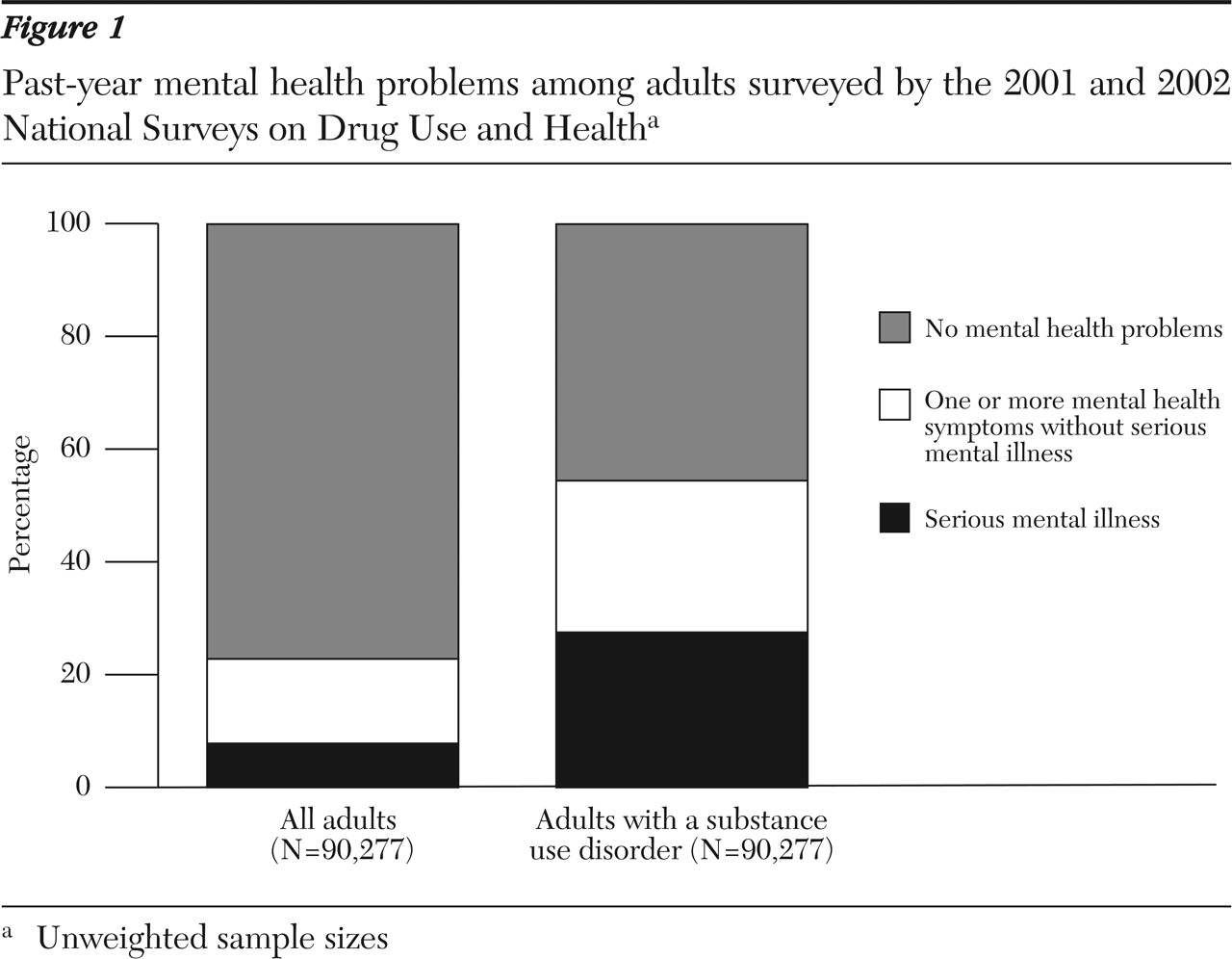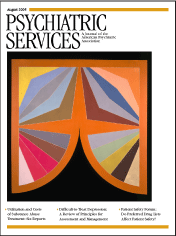Data
Data came from the 2001 and 2002 NSDUH, a survey conducted annually by the Substance Abuse and Mental Health Services Administration for the primary purpose of estimating the prevalence of illicit drug, alcohol, and tobacco use in the United States (
10,
11). The pooled sample included 137,055 respondents aged 12 years and older and had a combined response rate of 75 percent (
10,
11).
The survey takes roughly one hour to complete. To ensure confidentiality, questions about substance use, mental health problems, and treatment are completed through audio-assisted computer interview technology in which respondents key their responses directly into a laptop computer. Remaining questions are completed through an in-person interview that is computer assisted. Detailed information on data collection procedures and sampling design is available elsewhere (
10,
11).
Respondents were considered to have a substance use disorder if they reported three or more of the seven criteria for drug or alcohol dependence as specified in the American Psychiatric Association's
DSM-IV. Our analysis focused on the subpopulation of dependent adults because of our interest in service use and the growing use of treatment guidelines and placement criteria that limit access to treatment for patients with relatively severe problems. For example, recently issued guidelines by the Department of Veterans Affairs and the Department of Defense recommend that individuals who screen positive in general medical settings for dependence be referred to specialty-based treatment (
17) and those with less severe problems receive brief counseling.
In the absence of a standard for measuring objective mental health need, (
18,
19,
20) we employed two distinct and complementary measures. First, the presence of mental health symptoms among respondents aged 18 years and older was measured by using summary symptom questions drawn from the Composite International Diagnostic Interview-Short Form (CIDI-SF), which was adapted to screen for symptoms of nonaffective psychosis (
21,
22,
23,
24). The mental health symptoms covered in the surveys represent key constructs from the major disorders (major depressive disorder, mania, generalized anxiety disorder, panic attacks, social phobia, agoraphobia, and posttraumatic stress disorder). Second, we used a clinically validated indictor of serious mental illness in the past year (
21). The screener, also known as the K6, was developed for use in the U.S. National Health Interview Survey and was subsequently included in the NSUDH. The measure was intended to screen for serious mental illness, which was defined in Public Law 102-321 as having at least one 12-month
DSM-IV disorder (excluding substance use disorders) along with functional impairment. As a result, the measure is substantially more inclusive than other serious mental illness measures that rely on a previous psychiatric inpatient stay or a diagnosis of schizophrenia or other forms of psychosis.
The K6 is based on six questions that measure how frequently respondents experience symptoms of psychological distress (that is, feelings of nervousness, hopelessness, restlessness, depression, and worthlessness, and feeling as though everything is an effort) during the one month in the past year when they were feeling at their worst emotionally. Scale values range from 0 to 24, with a score of 13 or above indicating a high likelihood of serious mental illness. Both the modified CIDI-SF questions and the K6 items were structured such that positive responses were recorded if respondents indicated that specified symptoms were present any time during the past 12 months.
The survey asked a series of questions about the use of substance abuse treatment. Respondents were first asked whether they have received treatment or counseling for their use of alcohol or any drug, not including cigarettes, in the past 12 months, including detoxification and any other treatment for medical problems associated with drug or alcohol use. Next, respondents who answered affirmatively were asked about the form of treatment. We excluded individuals who reported either participation in self-help groups or brief counseling in emergency departments as their only form of treatment to better ensure that our results inform issues of access to and use of the paid care system. We would note that our results were virtually unchanged when our definition of treatment was broadened to include self-help groups, because a very small percentage of individuals in the NSDUH were dependent on substances in the past year used self-help as their only form of care.
Respondents were considered to use mental health care if they reported during the past 12 months having an inpatient stay for mental health treatment in a general or psychiatric hospital; receiving care in a mental health clinic; receiving mental health treatment in an office of a physician, private therapist, psychologist, psychiatrist, social worker, or counselor; receiving mental health treatment in a partial day hospital, day treatment program, or other location, such as a church, shelter, or school; or taking any medication prescribed to treat a mental or emotional condition. Throughout the section of the interview involving mental health care use, care was defined as "treatment or counseling for problems with emotions, nerves, or mental health," and respondents were explicitly asked to exclude treatment for alcohol and drug use when answering questions about use of mental health care.
Analyses
First, we calculated rates of substance use disorders and mental health problems among all adults aged 18 years and older, rates of substance use disorders among adults with mental health problems, and rates of mental health problems among adults with substance use disorders. Next we calculated rates of substance abuse treatment and mental health care use among five groups that were formed on the basis of the presence of a substance use disorder, mental health problem, or both in the past year: substance use disorder only (N=2,851), substance use disorder with one or more mental health symptoms and without serious mental illness (N=1,633), substance use disorder with serious mental illness (N=1,872), one or more mental health symptoms only (N=13,759), and serious mental illness only (N=7,530).
All proportions presented in descriptive tables were nationally weighted. Standard errors and difference in means tests were adjusted to account for the NSDUH's complex sampling design by using the survey analysis commands in STATA version 8.0 (
25).



